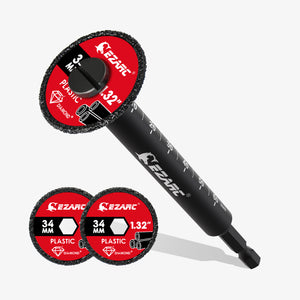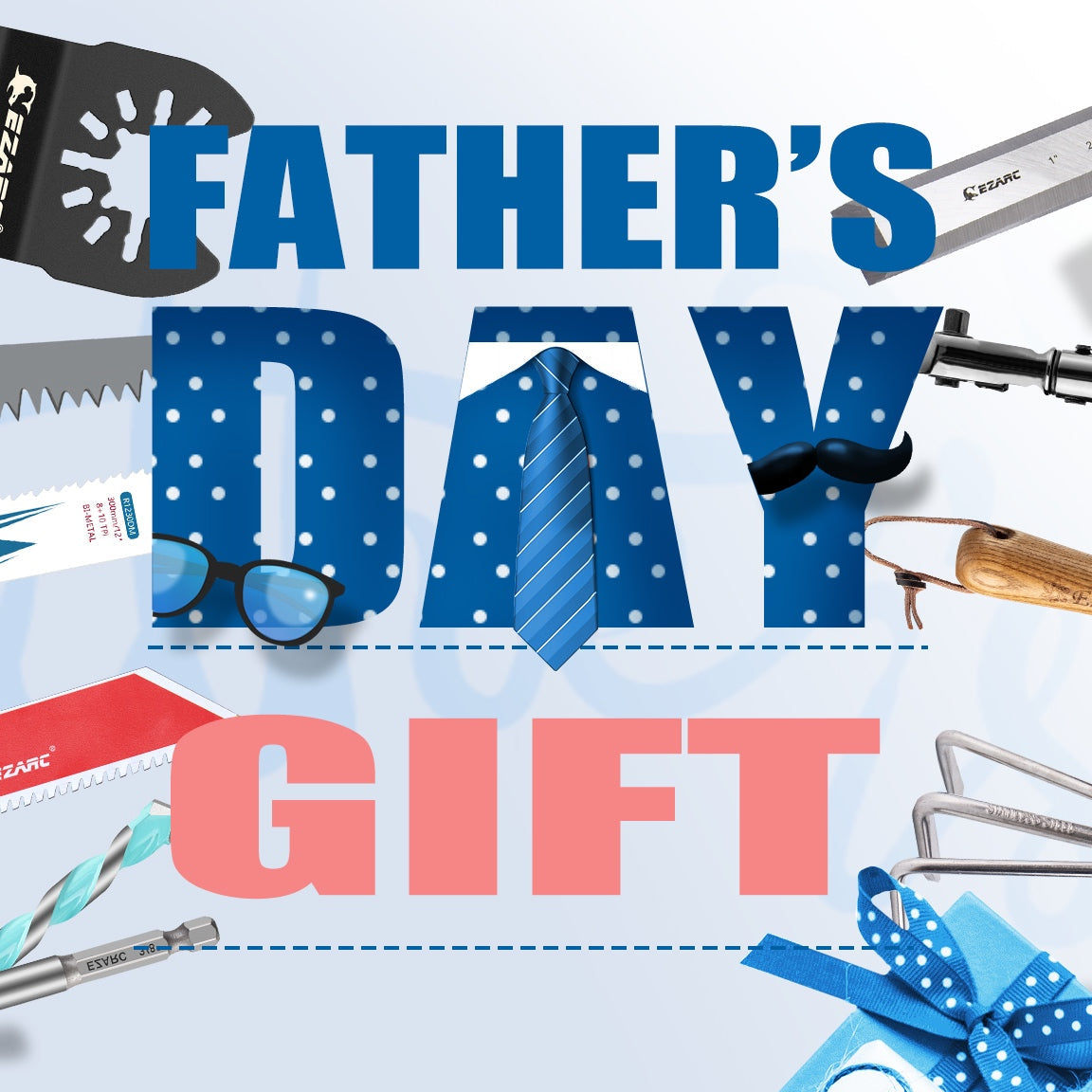Reciprocating saws can be an indispensable tool in daily demolition, cutting and repair work, and it can be a difficult task to choose the right reciprocating saw blade for different types of work. Once you pick up a wrong saw blade, it will have a certain impact on the work efficiency and the service life of the saw blade during the use process. Next, let's take a look at what's important when choosing a reciprocating saw blade.
There are many blade characteristics to consider, generally, it includes teeth per inch (TPI), blade material, length, width, shape and thickness.
-
Teeth per inch (TPI)
The basis of blade selection centers around the material you intend to cut. The material determines the Teeth Per Inch (TPI) needed to cut efficiently. This also provides the maximum blade life for that material.
The number of teeth per inch (TPI), along with gullet size, width and depth of the space between the teeth, determines the material the blade can cut.
Reciprocating saw blades range from 3 - 24 TPI. The low TPI blades cut fast but will leave rougher edges. Blades in the 3-6 TPI range are generally best for lumber and 6-10 TPI for demolition work. Pruning blades tend to be at the low end, while demolition/nail-eating blades tend to be around 8-12 TPI. General purpose wood cutting blades are in the middle, usually around 6 TPI, and can also cut nails.
Blades with higher TPI remove less material per pass. Therefore, they cut slower and leave smoother edges. Blades 12-18 TPI are typically used for metal and denser materials as well as finish curs in wood. The 18-24 TPI range is almost always used for thin metal cutting.
Combination blades have a variable TPI and are often used for both wood and metal cutting, and demolition. Different areas of the blade have different TPI, allowing the user to change the cut based on how they position the blade. For example, EZARC 8/10TPI blade has alternating sections of 8 TPI and 10 TPI for cutting wood and metal.
Pro Tip:
Try to have at least three teeth come in contact with the material at all times to reduce snagging, keeps the cut smooth, and helps you maintain control of the cut.
-
Blade Material
The material of the blade is the tradeoff between price and longevity. Blades made from stronger material cost more to manufacture, but last much longer. Cheaper blades are not always the better deal.
-
High Carbon Steel (HCS)
High Carbon steel blades are the cheapest and frequently used type. They're the softest of the blade materials and tend to be more flexible to permit bending without breaking within the proper application. Unfortunately, the teeth of a carbon steel blade are equally weak and less durable. It is suitable for cutting softer woods, fiberboards and plastics. Blades dull quickly when used on hardwoods, metals, and other hard materials. When cutting on hardwood, metal, and other hard materials, the blade will get dull quickly. However, the teeth can be grinded very sharp and cut fast into soft material as well.
-
High-Speed Steel (HSS)
High-speed steel blades are made with a tempering process that creates them more heat-resistant and sturdy than their steel counterparts. These blades last up to five times longer than steel blades. The hardness of the HSS blades makes them less flexible and thus more susceptible to breaking when bent. It also allows them to chop hardwoods, aluminum, and non-ferrous metal without dulling, excessive wear, and tooth breakage.
-
Bi-metal
Bi-metal blades are made from two or more types of metal. This allows the blade to combine the best properties of both carbon steel and high-speed steel in one blade. Bi-metal blades last ten times longer than a steel blade. The teeth are hard, while the blade is flexible. Unfortunately, the somewhat complicated manufacturing process makes these blades more expensive. While the cost slightly more than HSS or HCS blades, they offer the versatility and toughness for more demanding applications. This makes them the most popular blade type among people in the trades, auto yards, and other professions where sawzalls see frequent or daily use.
There’s big performance gap with different teeth material of bi-metal blades as well. Most bi-metal blades sold on Amazon you can choose are made of M2 cutting edge which are not contain any cobalt alloy, so the hardness is not very great as Diablo, Milwaukee and EZARC, because the bi-metal blades from these brands are generally with M42 teeth which have 8% cobalt on teeth, they can provide much longer lifetime than M2 teeth blades. We highly recommend bi-metal blades with M42 teeth because of their durability and long life.

-
Carbide
Carbide saw blades are also bi-metal blades, but it has a carbide (tungsten carbide or titanium carbide) tip at the end of each tooth. These carbide materials are extremely hard, heat-resistant, and impact-resistant. They also have 20 times the cutting life of standard bi-metal blades. They can cut thicker sheet metal, including cast iron, stainless steel, and high-strength alloys. This makes them ideal for cutting metals that would destroy HCS, HSS or traditional bi-metal blades almost instantly, such as grade 8 bolts and boron reinforced automotive struts.
Diablo, EZARC, Lenox and Milwaukee are now occupied the carbide technology advantage on this area.

Pro Tip:
When selecting a blade, remember this rule of thumb: The blade’s cutting edge must be harder than the material you are cutting.
-
Blade Length
The blade length determines the maximum length of cut that can be made with the blade. Reciprocating saw blade lengths range from 3" - 12". Standard lengths are 4”, 6”, 8”, 9” & 12”, with 6", 9" and 12” being the most commonly sold.
Short blades are more rigid and therefore more aggressive. That rigidity give you a straighter, more square cut, making them ideal for plunge cutting, copper pipe, and thinner metals. Longer blades are more flexible and can dissipate more heat since they have more surface area. Jobs like demolition, pruning, auto-dismantling, and rescue call for a longer blade. This flexibility also allows you to bend the blade when a flush cut is required.
The blade length you choose should always be slightly longer than the thickness of the material you are cutting. This reduces slipping and binding, and allows you some freedom of movement. If you get a blade that is too long the end can wobble, sometimes violently. This causes intense vibration, slowing down your cut, and can ultimately damage your work and lead to a bent blade.

Pro Tip:
Your blade length should always be 2" - 3" greater than the width of the material you are cutting.
-
Width&Shape
Wider blades offer more stability. They resist bending and vibration to provide straighter, more aggressive cuts. That extra support makes wider blades better for heavy duty applications such as demolition (nail-embedded wood), auto-dismantling, and fire & rescue. 3/4" - 1" are considered wide blades.
Blades with a lower width provide more flexibility for general purpose use or finer cutting. These typically fall within the 1/2" - 3/4" range. Very low widths are less than 1/2" thick and are typically used for scroll cutting - curved shapes and detail work in wood, metal, and plastic.
The blade's shape also makes a difference. Sloped shaped blades are better for plunge cutting. Straight blades are for edge cutting. Many blades have a notched or sloped tip, or a semi-tapered back, to make them able to perform both tasks adequately.
-
Blade Thickness
The blade thickness determines how well the blade resists bending. Blades made for critical applications are thicker. These blades will leave a square cut and won't quit before the cut is complete.
Economic blades are as thin as possible in order to keep costs down. Ideally the blade resists bending only as long as teeth on the blade keep cutting. Any extra rigidity is wasted material and money. If used carefully a thin blade can save money.
Most general duty blades are about 0.03" thick. Heavy duty blades come it at double that, or about 0.06".
Standard reciprocating saw blade thicknesses:
0.035" - standard duty
0.042" - medium-heavy duty
0.050" - heavy duty
0.062" - ultra heavy duty
Pro Tip:
Longer blades bend more easily. If that is not desired in your application, consider a thicker blade for lengths of 6" or greater.

 Oscillating Multi-Tool Blades
Oscillating Multi-Tool Blades
 Reciprocating Saw Blades
Reciprocating Saw Blades
 Cutting & Grinding
Cutting & Grinding
 Hole Saw
Hole Saw
 Drilling
Drilling
 Sanding & Polishing
Sanding & Polishing
 Hand Tools
Hand Tools
 Metal Worker & Fabrication
Metal Worker & Fabrication
 Woodworking & Carpentry
Woodworking & Carpentry
 Electrical & Plumbing
Electrical & Plumbing
 Automotive
Automotive
 Concrete & Masonry
Concrete & Masonry
 Demolition
Demolition
 NEW ARRIVALS
NEW ARRIVALS



2 コメント
Peter
Hi,
You should also have the length of the thick part.
You could have a chart or add this to your blade selection widget on your blade selection page.
Peter Munro
This is a great description of blades, but I do not see any width, height, tooth length etc in the specification or description of your blades.
コメントを書く
このサイトはhCaptchaによって保護されており、hCaptchaプライバシーポリシーおよび利用規約が適用されます。